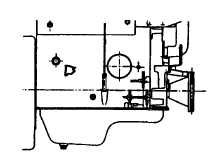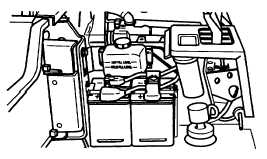| |
TM 10-3930-671-24
Engine Coolant Change
It is recommended to drain and replace the engine
coolant every 2000 hours, or once a year.
Cooling System Capacity: 9 quarts (8.5 L).
Refer to Section 2.1, Service Specifications.
Draining Radiator & Cooling System
WARNING
The radiator is very hot and pressurized
during vehicle operation. Let radiator
cool before removing cap. Failure to do
so can result in serious burns.
NOTE
The radiator does not have a drain fitting.
1.
Place a large drain pan (minimum capacity 11 q
[10.4 L]) under radiator and engine.
2.
Remove the radiator cap.
3.
Loosen hose clamp and remove the lower
coolant hose from radiator. Drain coolant into
drain pan.
4.
Remove coolant drain plug from engine block.
Drain coolant into drain pan.
5.
Inspect coolant hoses and clamps to determine
if they need to be replaced.
Cleaning & Flushing Cooling System
NOTE
If the condition of the used coolant
indicates severe contamination, rust
deposits, scale, or oil in the system, it
may be necessary to clean and flush
cooling
system
with
commercial
cleaner. Choose a product from a
reliable manufacturer and follow the
manufacturer’s recommendations in
its use.
1.
Install lower radiator hose.
2.
Install coolant drain plug in engine block.
3.
Fill cooling system and perform the cleaning and
flushing
operation
in
accordance
with
the
recommended procedure.
4.
Drain radiator and cooling system completely, as
noted above.
5.
Remove drain pan.
Filling Cooling System
NOTE
To cycle coolant from the recovery
reservoir into the radiator, run engine
until
it
reaches
operating
temperature, then stop the engine.
Check coolant level in the coolant
recovery reservoir when engine is
cold.
With entire cooling system drained, the following
procedure should be used to ensure complete fill:
1.
Fill radiator to the bottom of the filler neck
opening with new coolant. Use recommended
mixture only.
2.
Install radiator cap securely.
3.
Fill
the
coolant
recovery
(overflow)
bottle
reservoir to the ’COLD’ level line with coolant
mixture.
4.
Start and run engine until radiator upper hose is
warm, indicating thermostat is open and coolant
is circulating through the system. Check for
leaks at the hose connections and engine block
plug.
5.
Check coolant level in recovery reservoir when
coolant is cold. Add coolant as required to the
correct fill level.
F-97
|



